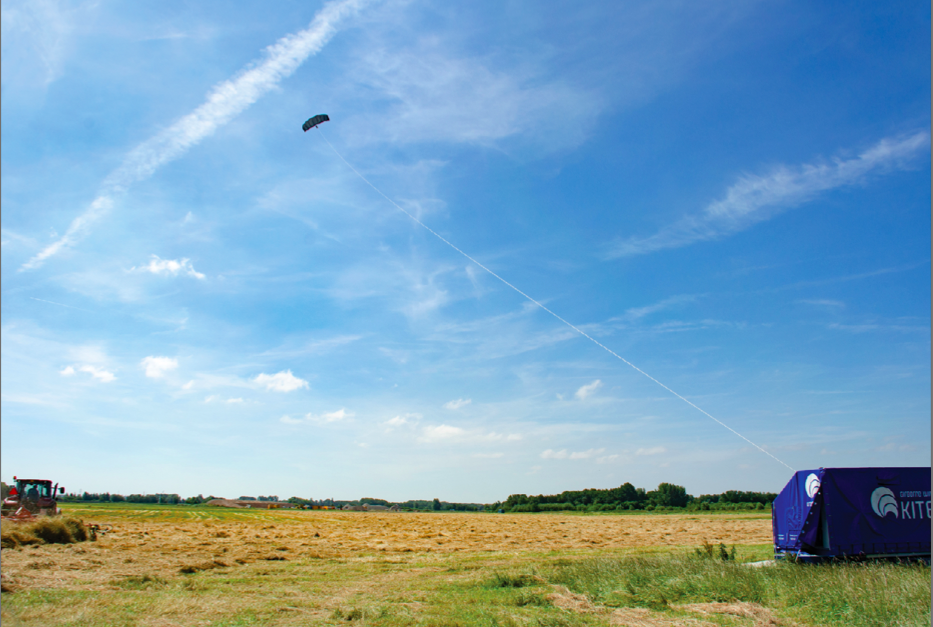
An old idea, that due to the development of better materials and new technology now “has the wind in its sails,” to coin a corny phrase. This is the kite from the Delft start-up Kitepower that can be used to generate sustainable energy. For the moment, it is primarily suited to remote, off-grid locations. However, some concerns have arisen about the disruption to the peace and quiet for birds around the Goeree-Overflakkee test site.
The idea dates back to 1980, Joep Breuer, CTO at Kitepower, points out. “Back then, Miles L. Loyd published a paper with several formulas which illustrated how a kite can generate energy.” The crux of the paper Crosswind kite power is that the energy generated can be more in terms of net power than the effort it takes to keep the kite airborne.
“It later gained traction in our country thanks to the Dutch astronaut Wubbe Ockels. He personally noticed by the way his hand got burned when flying a kite on the beach just how big a force it was capable;e of. We should do something with that,” he thought.”
Improved kite materials
It led to a focus on the phenomenon of generating electricity with kite technology as part of his academic chair, a patent, and ultimately to the founding of Kitepower in 2016.
Breuer: “It took a long time because materials and computational power were not available at that time. I am referring, for example, to the Dyneema lines from DSM. They are seven times lighter than steel but just as strong. And as far as steering technology is concerned, the mass has been replaced by intelligence. There are smaller computers like those used in drones and self-driving cars that we use to steer and harness the maximum amount of energy from wind.”
Four-component kite system
Kitepower’s kite system is made up of four components. A ground station that converts the mechanical energy of the kite using an alternator into electricity and also rolls the kite by using the generator as a motor. The line made by Dyneema provides a lightweight and strong connection between this station and the kite. A Kyte Control Unit controls the movements of the kite and handles communication between the sensor on the kite and the ground station. And finally the kite itself with an inflatable part and fiberglass skeleton. This is a combination of ruggedness and low weight that can reach heights of up to three hundred meters.

Breuer explains how it all works and how it differs from similar initiatives. “It’s a relatively simple product. Alternatives are more complicated and gravitate more towards a drone or aircraft. This means that we can enter the market sooner.”
“”In addition, the way we steer is different. The retrieval, when the maximum length of the line is reached, is very fast. We pull very hard on the line, which is connected to a large winch where the force is converted through a drum into a rotary motion that generates energy. By making that retrieval motion as short as possible, very little energy is lost for that particular action We flip the kite over. That way it becomes a kind of glider.”.
More energy bymaking figure of eights
The movement is similar to a figure of eight, and preferably not circles. “The best thing is to fly, as you do with sails, perpendicular to the wind. Also, think about a speedboat that someone is skiing behind. They don’t waterski straight behind the jetboat but make turns to go even faster. It works the same with a kite: by making figures of eight it goes quadratically faster, with a higher rate of efficiency. This is because the pulling power is quadratically dependent on the flight speed.”
Also interesting: Ocean Grazer to test storage system for wind energy in sand quarry
Going around in circles is much more ineffective, also because the cable gets tangled. Kitepower hopes to provide an alternative to wind turbines. “The kite goes higher with better wind speeds, ninety percent less material is needed with the potential to become even more efficient, and installation is much easier as well. We don’t need a large, fixed foundation.”
Breuer points, for example, to the prospect of applying this in the deepest seas. After all, Kitepower also wants to go offshore. A floating ground station would suffice; no heavy anchoring is needed as is the case with a wind turbine. Also, the kite would be more efficient and require less space than solar panels.
Test kite on Aruba was a success
Breuer cites as the biggest success so was the trip to Aruba last year. “Everything could be transported in a container, the system worked on-site and we were able to keep an eye on everything from the Netherlands.”
What about the rapid wear and tear of the equipment in comparison to wind turbines? “Replacement s form only a small part of the costs. After six months, by the way, a new, better version is then possible. In principle, no specialists need to be involved. In an earlier test in Marnewaard, soldiers were able to do this themselves after receiving our instructions.”
However, being able to meet the preconditions for a suitable location does present an obstacle. Now Goeree-Overflakkee has been chosen: a quiet area where safety will not be compromised if the kite were to fall. Yet the trial was suspended after complaints by Staatsbosbeheer (the Dutch National Forestry Service). Various bird species would be too frightened by the flapping of Kitepower’s Falcon.
Opinions divided on impact of the kite on birds
Opinions on the issue are divided. The ecological agency hired by Kitepower says that there is no significant impact on the quality of life of flora and fauna. But measurements taken on behalf of the Staatsbosbeheer indicate the opposite. A new permit must be applied for, which must clearly show the effect on the environment. We will have to wait for the permit because no flights can take place until the permit is issued.

Breuer says he wants to be sustainable precisely through the clean generation of energy. Consider, in particular, remote sites that will no longer be dependent on polluting and expensive diesel for generators. Potential disturbances to the peace and quiet for birds are at odds with the idea of sustainability. “It’s painful, but we just have to wait and see. But it can’t take too long, because investors are getting impatient.”
Providing 150 households with energy
Kitepower managed to raise €3 million last year. For now, this is enough to be able to enter the market with the first model. The current model, Falcon, features a kite measuring four by fifteen meters and is capable of generating 100kW per year, enough to power 150 households.
The system is too expensive for an average populated area to compete with other energy resources. Remote areas or more isolated places where the power supply is more expensive are more suitable. These include small islands, construction and infrastructure projects, mines, the oil and gas industry, the agricultural sector, and festivals.
Larger kites with more power should offer prospects for the future. Breuer lists steps from 200 to 300 and 500kW. “The same development as in the case of wind turbines.”

